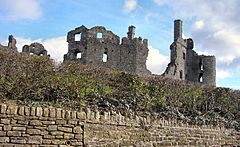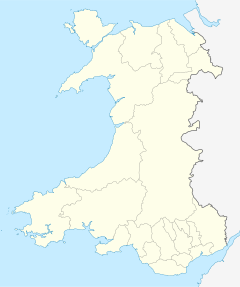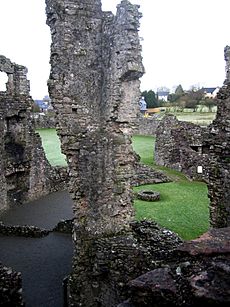Coity Castle facts for kids
Quick facts for kids Coity Castle |
|
|---|---|
| Glamorgan, Wales | |
 |
|
|
Shown within Wales
|
|
| Coordinates | 51°31′19″N 3°33′11″W / 51.521944°N 3.553056°W |
| Site information | |
| Owner | Cadw |
| Open to the public |
Yes |
| Condition | Ruined |
| Site history | |
| Materials | Stone |
Coity Castle (Welsh: Castell Coety) is a historic Norman castle located in Glamorgan, Wales. It was built by Sir Payn "the Demon" de Turberville. He was one of the famous Twelve Knights of Glamorgan. These knights were said to have conquered Glamorgan.
Today, Coity Castle is a ruin. It stands near the town of Bridgend. Close by is the old Church of St Mary the Virgin. This church has battlements and dates back to the 14th century. The castle is a Grade I listed building, which means it's a very important historical site.
Contents
The Story of Coity Castle
How Coity Castle Began
Coity Castle started as a simple earthwork fort. This was in the late 11th century. Later, the Norman de Turberville family added stone parts. They built a rectangular stone keep and a strong main curtain wall. These additions were made in the 12th century. The three-storey keep was mainly for defense.
Big Changes in the 14th and 15th Centuries
The castle was greatly changed in the 14th century. A living area, called a domestic range, was added. It was connected to the keep by the middle gatehouse. New stone ceilings, called vaults, replaced the old wooden floors. You can still see the central eight-sided stone pillar that supported these vaults.
In the 15th century, a chapel wing was added. It had a tall east window. This chapel was on the first floor of the domestic range.
Who Owned Coity Castle?
The de Turberville family owned Coity Castle for a long time. But in 1414, the ownership changed. The castle passed to the Gamage family. This happened through Sarah de Turberville. She was the youngest sister of Richard de Turberville. Sarah married William Gamage.
Getting the castle wasn't easy for the Gamage family. In 1412, William Gamage and Sir Gilbert Denys tried to take the castle by force. They besieged it for a month. They wanted to remove Lady Joan Verney, who was living there. She claimed the castle, but her claim was not strong. The king had to send people to stop the siege. Even though William Gamage and Gilbert Denys were briefly imprisoned, their actions helped the Gamage family eventually gain control. The Gamage family owned Coity Castle until 1584.
Life Inside: 16th Century Updates
During the 16th century, the Gamage family made many updates. They wanted to make the castle more comfortable. They added another storey to the living quarters. New windows and two chimney stacks were also built.
The main rooms were on the upper floors. There was a large hall on the first floor. Below it was a vaulted undercroft. You could reach the hall by a grand spiral staircase. On the west side were service rooms on the ground floor. These likely included a kitchen with ovens. You can still see the base of a large malting kiln. A tower in the curtain wall held latrines. The second floor had private apartments.
The Castle Today
Coity Castle was abandoned around the 17th century. It was later sold in the 18th century. The castle eventually came into the care of the Earls of Dunraven. Today, the castle ruins are looked after by Cadw. Cadw is a Welsh government body that protects historic sites.
A Castle on Rails
Did you know that a Great Western Railway Castle Class steam locomotive was named after Coity Castle? Its number was 5035.




